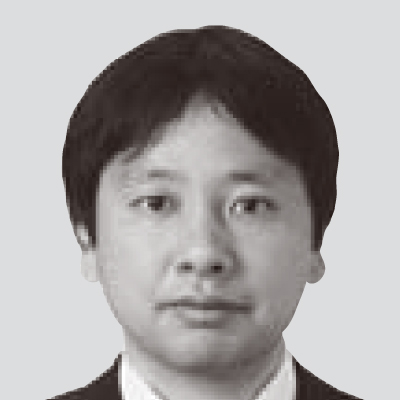Mobility Services for Better Urban Travel Experiences
Considerations such as making cities more compact and improving efficiency in the maintenance and upgrading of infrastructure call for a redesign of urban transportation. Meanwhile, the market environment associated with transportation is undergoing major changes that include progress toward autonomous driving and the emergence of the sharing economy. In response to changing societal needs, Hitachi is working to build next-generation transportation information platforms.

Smart Mobility Development Department, Smart Society Division, Urban Solutions Business Unit, Hitachi, Ltd. Current work and research: Business development of urban mobility solutions.

Systems Architecture Research Department, Center for Technology Innovation – Systems Engineering, Research & Development Group, Hitachi, Ltd. Current work and research: Research of new mobility systems and businesses. Society memberships: The Institute of Electrical Engineers of Japan (IEEJ), The Society of Socio-Informatics (SSI), Information Processing Society of Japan (IPSJ), and The Operations Research Society of Japan (ORSJ).

Network Systems First Department, IoT & Cloud Services Business Division, Services & Platforms Business Unit, Hitachi, Ltd. Current work and research: Business promotion of open data utilization.

Smart Mobility Development Department, Smart Society Division, Urban Solutions Business Unit, Hitachi, Ltd. Current work and research: Business development of urban mobility solutions.

Systems Architecture Research Department, Center for Technology Innovation – Systems Engineering, Research & Development Group, Hitachi, Ltd. Current work and research: Development of traffic management systems for railway and autonomous vehicles.
The aging population and falling birthrate calls for a realignment of urban transportation functions. In cities, the services expected from transportation are becoming more diverse due to factors such as increasing numbers of overseas visitors and active senior citizens. It is anticipated that opportunities for utilizing public transportation will be boosted by choosing modes of transportation that suit the size of the city and level of demand, and by the collection, processing, and delivery of transportation information that is spread around the different service providers and elsewhere. In rural areas, meanwhile, high hopes are being placed on “last-mile” transportation services as a way of dealing the various problems facing transportation agencies in those areas, including aging, depopulation, and the shortage of drivers. These services provide flexible ways for people to travel from existing public transportation sites such as railway stations and bus stops to their desired destination, which might be a hospital, shopping center, or their home.
In a society where autonomous driving is entering widespread use, mobility services that combine the technology of autonomous driving with the provision of accurate information, traffic management, and relevant information on the weather or unexpected events, etc. is expected to provide a safe transportation environment and alleviate congestion.
Looking ahead to the future widespread adoption of autonomous driving, Hitachi, Ltd. is working to develop underlying technologies and to explore practical applications that should provide platforms that support seamless travel across different modes of transportation and freedom of movement that suits diverse user needs. Its objective is to create a transportation environment that is comfortable and convenient. Figure 1 shows a diagram of an urban transportation information platform. The aim is to provide services with high added value to a wide variety of businesses by consolidating information on route directions for individuals and commercial freight and logistics as well as information on public and personal transportation.
This article describes examples of the activities shown in the diagram of the urban transportation information platform from the perspectives of public and personal transportation.
Figure 1—Urban Transportation Information Platform The platform provides operational support for transportation operators through the collection and analysis of data on multi-modal transportation. It supports freedom of movement based on the preferences of public transportation users and traffic conditions.
The platform provides operational support for transportation operators through the collection and analysis of data on multi-modal transportation. It supports freedom of movement based on the preferences of public transportation users and traffic conditions.
Automated driving systems are one of the topics included in the Strategic Innovation Promotion Program (SIP) that forms part of Japan’s national science and technology policy. In addition to reducing traffic accidents and developing and promoting the widespread adoption of autonomous driving systems, the program is targeting the practical implementation of advanced rapid transit (ART), a next-generation urban transportation system, for which the major international sporting events of 2020 will serve as a milestone.
Hitachi has been contracted by the New Energy and Industrial Technology Development Organization (NEDO) to work on the ART Information Center, a transportation information platform for supporting public transportation in cities. The following sections give an overview of the ART Information Center and describe its main functions along with an integrated transportation simulation that is linked with the center.
The ART Information Center is an open platform for the collection and utilization of information relating to public transportation. Its purpose is to help resolve the issues associated with transportation by providing valuable information and functions to both the operators and users of public transportation, including ART (see Figure 2).
Figure 2—Overview of ART Information Center The ART Information Center has links to a variety of public transportation agencies to help improve convenience for users as well as providing information to operators.
The ART Information Center has links to a variety of public transportation agencies to help improve convenience for users as well as providing information to operators.
The ART Information Center is made up of, (1) an inbound data platform for collecting external data, (2) a data portal platform for providing information to transportation operators and others, (3) a data archiving and analysis platform, (4) a support platform for application developers, and (5) a platform for integrated system operation (see Figure 3).
The inbound data platform (1) and data portal platform (2) function as gateways for sending data to and from other associated systems or applications. Their purpose is to reliably exchange data with various relevant service providers, systems, and applications. An application programming interface (API) has been defined and the platforms are undergoing testing based on this standardized interface.
In the data storage and analysis platform (3), data storage utilizes a database that is separated into tiers based on the type of data and how it is used. While data accessed via the API is currently processed and converted to suit different purposes within the center before being passed to applications, the future aim is to not only process and convert data, but also to progressively add new functions to provide information that is useful to society by implementing capabilities such as analysis and visualization that use the data.
The support platform for application developers (4) is intended to encourage the use of data by providing a development and runtime environment for businesses and developers who want to create applications that use data stored in the ART Information Center.
The integrated operation platform (5) provides functions such as system resource management and security to ensure the reliability and availability of the ART Information Center.
Open platforms need to be scalable. By taking advantage of its ability to scale in step with associated systems and processing load, the ART Information Center can serve as a platform for providing various different types of information, with the potential for interoperation with integrated transportation simulations and systems for last-mile transportation services. Along with applying the expertise in system design, implementation, and operation that it has built up in the past, Hitachi is also seeking to create a platform that supports comfortable ways for people to travel that are safe and secure by applying open and up-to-date technologies to various functions.
Figure 3—Block Diagram of the ART Information Center The ART Information Center collects and processes information on buses and service operators to provide information to application providers via an API as well as information for public transportation administrators that assists with their operations.
The ART Information Center collects and processes information on buses and service operators to provide information to application providers via an API as well as information for public transportation administrators that assists with their operations.
Interoperation between the different forms of urban transportation, including trains, buses, and taxis, is expected to increase significantly in the future. While providing the public with more flexible and convenient transportation, this will also expand the scope of impact exerted by changes in traffic conditions in specific locations. It is anticipated, for example, that providing information that can be used to predict how traffic conditions will change under certain circumstances (such as delays in railway services due to the flow-on effects of crowding that arise from a short-term rise in user numbers) will allow both users and administrators to take mitigating actions, thereby helping to quickly resolve disruptions.
Hitachi has been studying simulations of how traffic flows change based on traffic conditions and railway operations in the surrounding area. Figure 4 shows an overview. The system includes simulations of both railway services and road traffic, combining these to predict changes in urban transportation. Information on current railway services and traffic conditions is obtained from the data stored in the ART Information Center and provided as input to the railway and traffic simulators. These simulators are then run to obtain the results. The interconnection between the two simulations makes it possible to estimate how increases in railway passenger and vehicle numbers influence each other. This configuration also helps future-proof the system because the effects of any future modifications to the railway or traffic simulators can be handled by the interconnection between the two simulations.
Figure 4—Use of Integrated Transportation Simulation The simulation generates predictions that combine information about both traffic conditions and railway services to estimate the flow-on effects of transportation changes at specific locations.
The simulation generates predictions that combine information about both traffic conditions and railway services to estimate the flow-on effects of transportation changes at specific locations.
As a subcontractor to the National Institute of Advanced Industrial Science and Technology (AIST), the organization contracted by the Ministry of Economy, Trade and Industry to undertake a research and development/demonstration project aimed at the practical implementation of last-mile mobility systems in designated areas using autonomous driving and similar technology, Hitachi was contracted to conduct research into traffic management systems and dispatch logic for last-mile transportation systems. The following sections describe this work.
Based on small, autonomous driving electric carts that follow electromagnetic guide wires, this demonstration project involved the development and testing of such technologies as automated vehicle control, the use of electronic coupling for platooning vehicles (driving in convoy), remote monitoring and control, and traffic management systems. By utilizing vehicle control techniques that use electromagnetic guide wires and other infrastructure, the project was not limited only to fully autonomous automated vehicles and was instead able to choose from a variety of autonomous driving technologies depending on the conditions. This allows for places where there is poor reception of position information from a global navigation satellite system (GNSS).
During FY2017, the project mainly involved technical trials at three test sites that were chosen as indicative of the different ways the system would be used in practice (Chatan Town, in Okinawa Prefecture, served as a model tourist destination; Wajima City, in Ishikawa Prefecture, as a model urban area; and Eiheiji Town, in Fukui Prefecture, as a model of a lightly-populated area), with a demonstration project that includes commercial evaluation planned for FY2018.
Last-mile transportation services represent a new type of transportation system using automated vehicles, and studies in preparation for commercial application are proceeding, including studies to determine the societal requirements and to identify issues (see Figure 5).
Figure 5—Overview of Last-mile Transportation Service and Control Center Last-mile transportation services are a new type of transportation system using automated vehicles that run from existing public transportation to public and commercial facilities or people’s homes. The last-mile transportation control center manages and controls system operation.
Last-mile transportation services are a new type of transportation system using automated vehicles that run from existing public transportation to public and commercial facilities or people’s homes. The last-mile transportation control center manages and controls system operation.
In the context of last-mile transportation systems, a traffic management system is one that appropriately manages the operation of individual vehicles or groups of vehicles, playing an indispensable role in adjusting the number of vehicles based on passenger demand and dealing with unexpected events due to things like road conditions or vehicle faults.
The three basic functions that make up a traffic management system are the formulation and revision of traffic plans, operation monitoring and supervision, and passenger information. Traffic management systems also include dispatch logic that controls how they formulate and revise traffic plans (see Figure 6).
The demonstration project was based on a last-mile transportation and freight service that uses vehicles that support platooning using electronic coupling, with autonomous driving that works by following electromagnetic guide wires. It involved implementing a traffic management function for platoons of these vehicles. Core functions were modelled to ensure they would be able to work with a variety of different vehicles and service models that could potentially be used when the system is rolled out to the public, including future fully autonomous automated vehicles driving on their own or in a convoy. Work is also proceeding on the development of highly flexible systems by designing an architecture that makes it easy to swap functions in or out for each of the different modes of operation.
Figure 6—Overview of Traffic Management System for Last-mile Transportation The central system for last-mile transportation includes a traffic management system and remote control (monitoring). Traffic management means appropriately managing the operation of individual vehicles or groups of vehicles. The key components are the formulation and revision of traffic plans, operation monitoring and supervision, and passenger information, with the dispatch logic playing a core role.
The central system for last-mile transportation includes a traffic management system and remote control (monitoring). Traffic management means appropriately managing the operation of individual vehicles or groups of vehicles. The key components are the formulation and revision of traffic plans, operation monitoring and supervision, and passenger information, with the dispatch logic playing a core role.
Development at the Hitachi Group goes beyond individual technologies. Rather, in order to form part of social systems, Hitachi is deepening its relationships with partners to measure the benefits for a variety of different stakeholders as it works to help resolve the transportation challenges faced by society. With the aim of building the next generation of transportation information platforms, Hitachi intends to press on with the practical implementation of the ART Information Center and last-mile transportation services.
Some of this work was undertaken as part of the “Strategic Innovation Promotion Program (Automated Driving Systems): Development of Functions Needed to Build ART Information Center” (FY2016) and “Research and Development and Demonstration Project in Preparation for Practical Implementation of Advanced Automated Driving Systems: Trials in Preparation for Practical Implementation of Last-mile Mobility Systems in Designated Areas Using Automated Driving and Similar Technology” research funded by the Ministry of Economy, Trade and Industry; and the “Strategic Innovation Promotion Program (SIP) Automated Driving System/Large-scale Demonstration Project/Next-generation Urban Transportation/Establishment of Practices for the Collection and Archiving of Data Relating to ART Operations and the Provision of Information to ART Users and Others, and the Implementation and Management of Large-scale Demonstration Projects” funded by NEDO.